Abstract
Using an experimental endocarditis model, we studied the activity of daptomycin used alone or in combination with gentamicin against an Enterococcus faecium strain that was highly resistant to glycopeptides and susceptible to gentamicin. In vitro, the MIC of daptomycin was 1 micrograms/ml. In vivo, daptomycin appeared to be effective only when it was used in a high-dose regimen, i.e., 12 mg/kg of body weight every 8 h (-2.5 log10 CFU/g versus controls; P < 0.05), particularly when it was combined with gentamicin (-5.0 log10 CFU/g versus controls; P < 0.01). Since the distribution of daptomycin into cardiac vegetations, as evaluated by autoradiography, appeared to be homogeneous, the poor in vivo activity of daptomycin was considered to be related to its high degree of protein binding, as suggested by killing curves studies. Since the MIC of teicoplanin for the vancomycin-resistant E. faecium strain used in the study was only 64 micrograms/ml and since an in vitro synergy between teicoplanin at high dose and gentamicin was observed, a high-dose regimen of teicoplanin, i.e., 40 mg/kg every 12 h, was also assessed in vivo. This treatment provided marginal activity only when it was combined with gentamicin (-2.3 log10 CFU/g versus controls; P < 0.05). These results suggest that the levels of daptomycin or teicoplanin in serum required to cure experimental endocarditis caused by a highly glycopeptide-resistant strain of E. faecium would not be achievable in humans.
Full text
PDF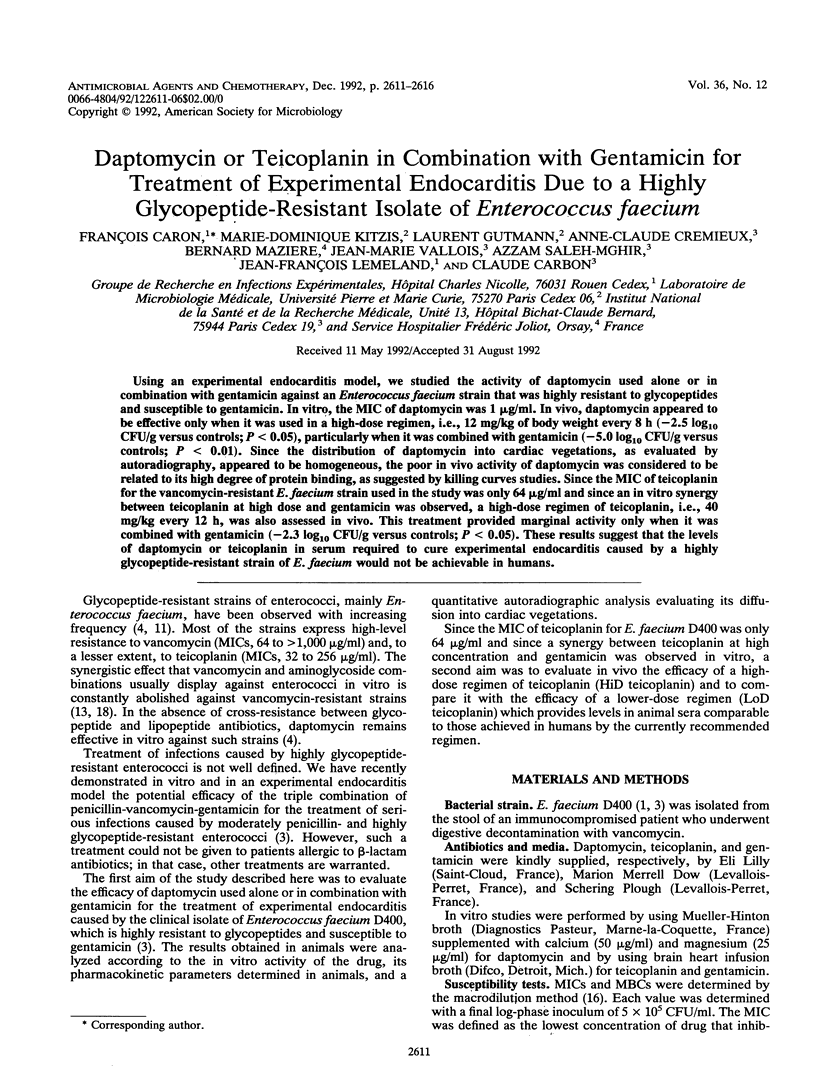
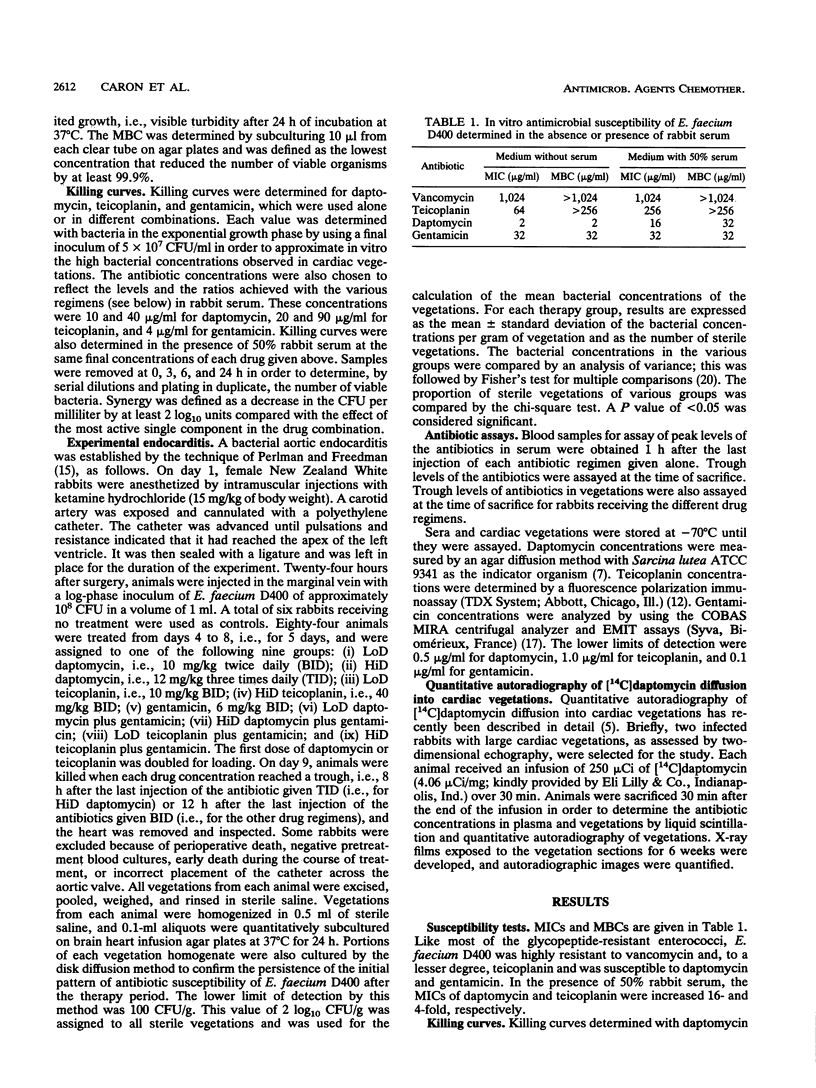
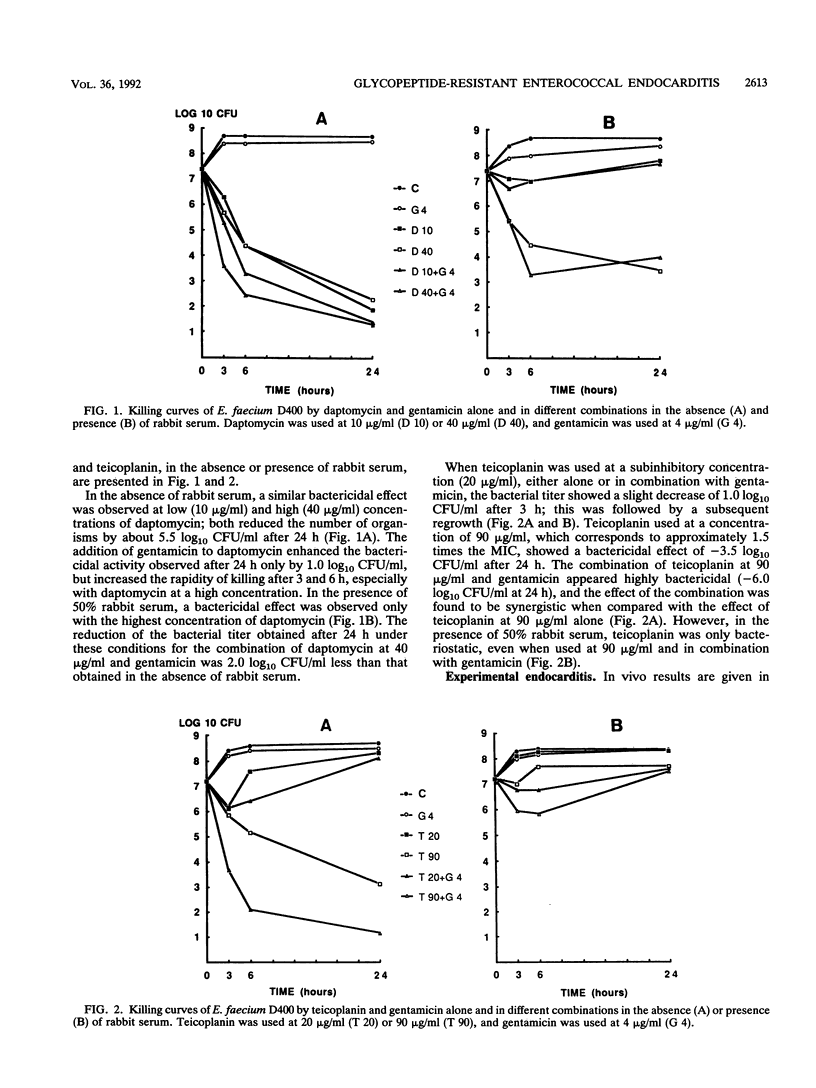

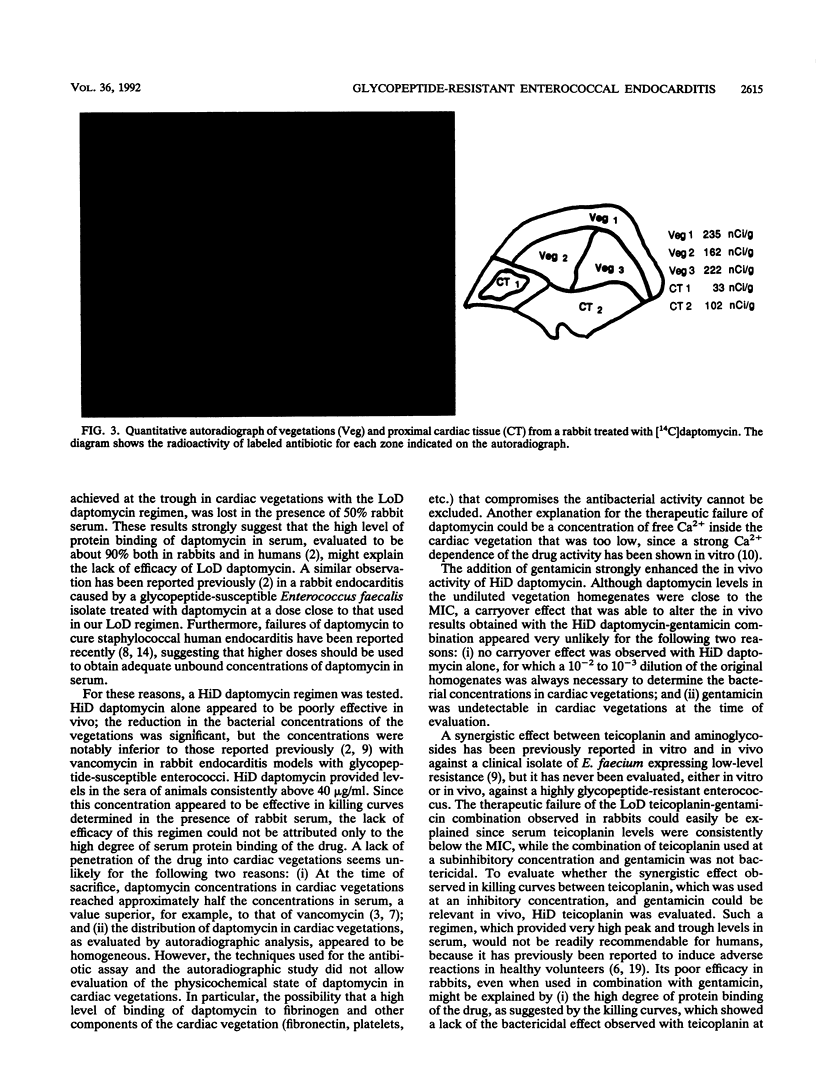
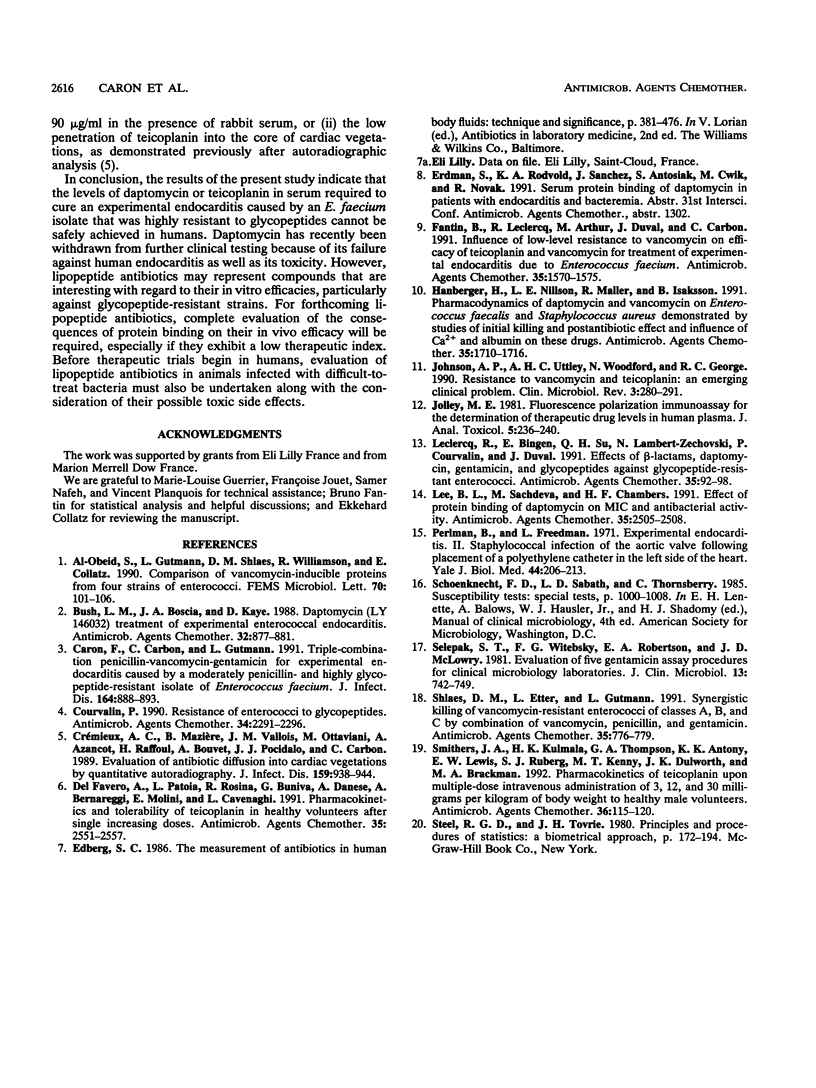
Images in this article
Selected References
These references are in PubMed. This may not be the complete list of references from this article.
- Bush L. M., Boscia J. A., Kaye D. Daptomycin (LY146032) treatment of experimental enterococcal endocarditis. Antimicrob Agents Chemother. 1988 Jun;32(6):877–881. doi: 10.1128/aac.32.6.877. [DOI] [PMC free article] [PubMed] [Google Scholar]
- Caron F., Carbon C., Gutmann L. Triple-combination penicillin-vancomycin-gentamicin for experimental endocarditis caused by a moderately penicillin- and highly glycopeptide-resistant isolate of Enterococcus faecium. J Infect Dis. 1991 Nov;164(5):888–893. doi: 10.1093/infdis/164.5.888. [DOI] [PubMed] [Google Scholar]
- Courvalin P. Resistance of enterococci to glycopeptides. Antimicrob Agents Chemother. 1990 Dec;34(12):2291–2296. doi: 10.1128/aac.34.12.2291. [DOI] [PMC free article] [PubMed] [Google Scholar]
- Cremieux A. C., Maziere B., Vallois J. M., Ottaviani M., Azancot A., Raffoul H., Bouvet A., Pocidalo J. J., Carbon C. Evaluation of antibiotic diffusion into cardiac vegetations by quantitative autoradiography. J Infect Dis. 1989 May;159(5):938–944. doi: 10.1093/infdis/159.5.938. [DOI] [PubMed] [Google Scholar]
- Del Favero A., Patoia L., Rosina R., Buniva G., Danese A., Bernareggi A., Molini E., Cavenaghi L. Pharmacokinetics and tolerability of teicoplanin in healthy volunteers after single increasing doses. Antimicrob Agents Chemother. 1991 Dec;35(12):2551–2557. doi: 10.1128/aac.35.12.2551. [DOI] [PMC free article] [PubMed] [Google Scholar]
- Fantin B., Leclercq R., Arthur M., Duval J., Carbon C. Influence of low-level resistance to vancomycin on efficacy of teicoplanin and vancomycin for treatment of experimental endocarditis due to Enterococcus faecium. Antimicrob Agents Chemother. 1991 Aug;35(8):1570–1575. doi: 10.1128/aac.35.8.1570. [DOI] [PMC free article] [PubMed] [Google Scholar]
- Hanberger H., Nilsson L. E., Maller R., Isaksson B. Pharmacodynamics of daptomycin and vancomycin on Enterococcus faecalis and Staphylococcus aureus demonstrated by studies of initial killing and postantibiotic effect and influence of Ca2+ and albumin on these drugs. Antimicrob Agents Chemother. 1991 Sep;35(9):1710–1716. doi: 10.1128/aac.35.9.1710. [DOI] [PMC free article] [PubMed] [Google Scholar]
- Johnson A. P., Uttley A. H., Woodford N., George R. C. Resistance to vancomycin and teicoplanin: an emerging clinical problem. Clin Microbiol Rev. 1990 Jul;3(3):280–291. doi: 10.1128/cmr.3.3.280. [DOI] [PMC free article] [PubMed] [Google Scholar]
- Jolley M. E. Fluorescence polarization immunoassay for the determination of therapeutic drug levels in human plasma. J Anal Toxicol. 1981 Sep-Oct;5(5):236–240. doi: 10.1093/jat/5.5.236. [DOI] [PubMed] [Google Scholar]
- Leclercq R., Bingen E., Su Q. H., Lambert-Zechovski N., Courvalin P., Duval J. Effects of combinations of beta-lactams, daptomycin, gentamicin, and glycopeptides against glycopeptide-resistant enterococci. Antimicrob Agents Chemother. 1991 Jan;35(1):92–98. doi: 10.1128/aac.35.1.92. [DOI] [PMC free article] [PubMed] [Google Scholar]
- Lee B. L., Sachdeva M., Chambers H. F. Effect of protein binding of daptomycin on MIC and antibacterial activity. Antimicrob Agents Chemother. 1991 Dec;35(12):2505–2508. doi: 10.1128/aac.35.12.2505. [DOI] [PMC free article] [PubMed] [Google Scholar]
- Perlman B. B., Freedman L. R. Experimental endocarditis. II. Staphylococcal infection of the aortic valve following placement of a polyethylene catheter in the left side of the heart. Yale J Biol Med. 1971 Oct;44(2):206–213. [PMC free article] [PubMed] [Google Scholar]
- Selepak S. T., Witebsky F. G., Robertson E. A., MacLowry J. D. Evaluation of five gentamicin assay procedures for clinical microbiology laboratories. J Clin Microbiol. 1981 Apr;13(4):742–749. doi: 10.1128/jcm.13.4.742-749.1981. [DOI] [PMC free article] [PubMed] [Google Scholar]
- Shlaes D. M., Etter L., Gutmann L. Synergistic killing of vancomycin-resistant enterococci of classes A, B, and C by combinations of vancomycin, penicillin, and gentamicin. Antimicrob Agents Chemother. 1991 Apr;35(4):776–779. doi: 10.1128/aac.35.4.776. [DOI] [PMC free article] [PubMed] [Google Scholar]
- Smithers J. A., Kulmala H. K., Thompson G. A., Antony K. K., Lewis E. W., Ruberg S. J., Kenny M. T., Dulworth J. K., Brackman M. A. Pharmacokinetics of teicoplanin upon multiple-dose intravenous administration of 3, 12, and 30 milligrams per kilogram of body weight to healthy male volunteers. Antimicrob Agents Chemother. 1992 Jan;36(1):115–120. doi: 10.1128/aac.36.1.115. [DOI] [PMC free article] [PubMed] [Google Scholar]
- al-Obeid S., Gutmann L., Shlaes D. M., Williamson R., Collatz E. Comparison of vancomycin-inducible proteins from four strains of Enterococci. FEMS Microbiol Lett. 1990 Jun 15;58(1):101–105. doi: 10.1016/0378-1097(90)90110-c. [DOI] [PubMed] [Google Scholar]



